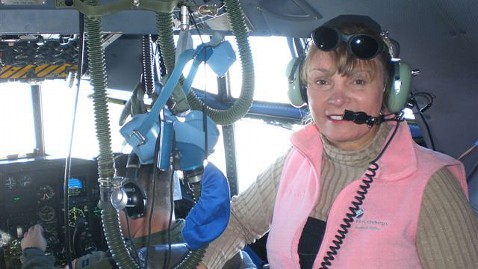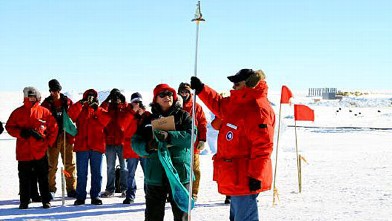South Pole: Woman Pushes for Rescue After Stroke at Amundsen-Scott Station

Renee-Nicole Couceur in a picture she emailed from Antarctica.
“Great God! This is an awful place,” wrote Robert Falcon Scott when he reached the South Pole in 1912. He and his four comrades got there in January — the height of summer in the Southern Hemisphere — a month after Roald Amundsen’s team, and died in the cold as they tried to walk back to safety.
Now it is winter at the pole, and Renee-Nicole Douceur, the manager of the Amundsen-Scott research station there, says she is trapped after she suffered a stroke in August. Her niece, Sydney Raines, has mounted an online campaign to get her out of there, even though Raytheon Polar Services, which runs the station for the National Science Foundation, says it is still too dark, cold and dangerous to send a plane for her.
Raytheon says it will try to send a plane in a week. It will be a risky operation, trying to land without runway lights, possibly in winds that can send snow blowing high into the air. The cold is such that if the plane turns off its engines, its fuel may take on the consistency of jelly or caramel.
“The stroke has affected my stereo vision,” wrote Douceur in a post on SaveRenee.org. “Though I see OK far but when I try to read I only see the first few words of a sentence before I need to shift and refocus on the next several words. When I read paragraphs I get easily mixed up trying to distinguish sentences.”
On Sunday, Douceur, who is from Seabrook, N.H., gave a telephone interview to WMUR-TV, the ABC affiliate in Manchester, N.H. “We’re running kind of cool, we’re about minus 74 degrees right now,” she said.

Image from Renee-Nicole Douceur's Facebook page.
Doctors in the U.S., queried by ABC News, said they did not want to comment on Doceur’s condition from afar, but agreed the critical time for a stroke patient is the first few hours.
“Strokes, in general, need to be diagnosed quickly,” said Dr. Ralph Sacco of the University of Miami. “We’re obviously way beyond that now.”
But the fact that she’s been giving interviews is promising, said Dr. Patrick Lyden of Cedars-Sinai Medical Center in Los Angeles.
“She has not had a massive or even moderate stroke,” he wrote in an email. “She is stable. From what I read, it seems as though the risk of an evacuation outweighs the risk of stroke complications. But I don’t know her status.”
Jonathan Kasle of Raytheon sent a statement which said in part, “During the winter period, extremely cold temperatures and high winds make an extraction dangerous for all involved, passengers as well as crew, and such an extraction is considered only in life threatening conditions.”
The National Science Foundation provided one too: “We recognize this individual and all of those who deploy with the U.S. Antarctic Program, doing work of national and even global significance, which by its nature entails a great deal of personal sacrifice and some risk.”

Amundsen-Scott Station at the South Pole. Credit: Daniel Leussler
If all goes well, Douceur would be flown to New Zealand, where she can get a CT scan or an MRI, and appropriate treatment to reduce the chance of further harm.
“I am aware of the risk” of mounting a rescue flight, Douceur said in a telephone interview with ABC News late today. “I would not, in extremely bad weather, jeopardize a crew of pilots to come and rescue me.”